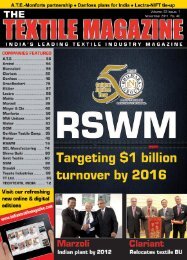policy initiatives - Textile Magazine
policy initiatives - Textile Magazine
policy initiatives - Textile Magazine
You also want an ePaper? Increase the reach of your titles
YUMPU automatically turns print PDFs into web optimized ePapers that Google loves.
international regulations<br />
Growing awareness of ill-effects<br />
of chemicals in textiles<br />
In the wake of renewed<br />
consumer concern about<br />
the chemicals used in<br />
clothes and footwear and<br />
their potential for harmful<br />
effect on both individuals<br />
and the environment,<br />
national and international<br />
regulatory frameworks<br />
such as REACH and CP-<br />
SIA have been created<br />
with the aim of restricting<br />
and prohibiting the use<br />
of such substances. Restricted<br />
substances now<br />
abound within the textile<br />
industry in the light of<br />
consumer awareness.<br />
Restricted substances, including<br />
harmful chemicals, can pose grave<br />
danger to people, the environment<br />
and companies using them. The recall<br />
of a product for use of dangerous<br />
substances can cause irretrievable<br />
damage to a company’s reputation.<br />
Greenpeace International, for example,<br />
in its recent publication, ‘Dirty<br />
Laundry 2: Hung Out to Dry’, focused<br />
on the use of the chemical nonylphenolethoxylate<br />
(NPE) and its<br />
release into the environment from<br />
its use in the manufacture of clothes<br />
and footwear. The example highlights<br />
how concern over chemicals<br />
doesn’t impact merely at the point<br />
of production. It can also come up at<br />
the point of sale, affecting both company<br />
sales and consumer choice.<br />
Many restricted substances are of<br />
the group considered harmful to the<br />
environment and unfit for public exposure,<br />
creating new challenges for<br />
companies that manufacture and sell<br />
clothes and footwear. The industry<br />
has reacted by implementing an integrated<br />
approach and presenting a<br />
united front as it meets the requirements<br />
posed by local and international<br />
manufacturing regulation,<br />
international standards, chemical<br />
specifications and consumer product<br />
regulation. Hazardous chemicals<br />
now have to be identified and assessed<br />
throughout the entire supply<br />
chain.<br />
It is therefore of the utmost importance<br />
that the control and management<br />
of risk is undertaken at every<br />
point along the supply chain so as<br />
to ensure that the final product has<br />
86 | The <strong>Textile</strong> <strong>Magazine</strong> jANUARY 2012






